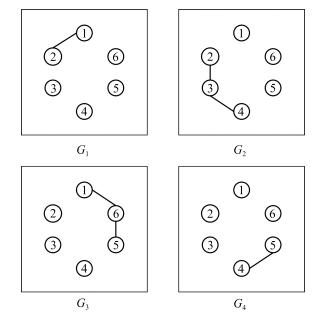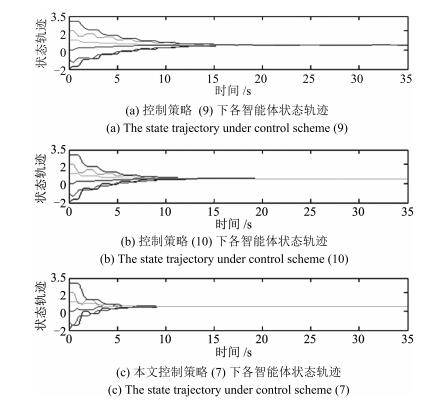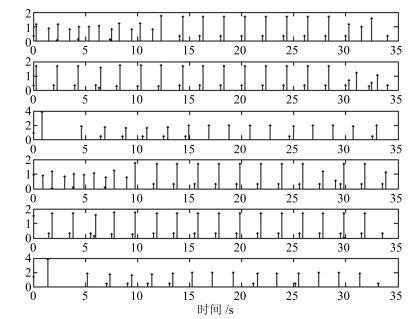Event-triggered Fast Consensus Algorithm for Multi-agent Systems Under Jointly-connected Topology
-
摘要: 针对组合连通拓扑下多智能体系统控制过程中存在通信和计算资源损耗大以及系统收敛速度慢等问题,提出一种新的具有状态预测器的事件触发一致性控制协议,通过设计状态预测器使每个智能体都能对其邻居智能体的未来状态作出预测;同时,对于智能个体给出了基于状态信息的事件触发条件,当状态误差满足该条件才触发事件.在该控制策略下多智能体系统可在节约通信和计算资源的同时具有更快的收敛速度.利用Lyapunov稳定性理论和代数图论,证明了所提事件触发控制策略能够有效实现组合连通拓扑结构下的平均一致性,且不存在Zeno行为.仿真实例进一步验证了理论结果的有效性.Abstract: This paper investigates the event-triggered consensus problem of multi-agent systems under jointly-connected topology. In order to reduce the unnecessary waste of limited communication and computing resources as well as improve convergence rate, a novel event-triggered consensus control law with state predictor is proposed. In particular, every agent can predict the future state of its neighbor; meanwhile, for each agent a state-dependent event condition is given, and only when state error satisfies this event condition, can the event be triggered. This control strategy can lead to a significant reduction of information communication burden in a multi-agent network and improvement of convergence rate. Based on the Lyapunov stability theorem and algebraic graph theory, the proposed event-triggered control strategy is proven to be able to implement the average consensus when the topology is jointly-connected. Moreover, such strategies can exclude Zeno-behavior. Finally, numerical simulations are given to illustrate the effectiveness of the theoretical results.
-
Key words:
- Multi-agent systems /
- event-triggered control /
- fast consensus /
- jointly-connected
-
-
表 1 事件条件(7), (9)和(10)下平均触发间隔
Table 1 The average triggered interval under event conditions (7), (9) and (10)
拓扑切换 事件条件(s) 周期(s) 式(7) 式(9) 式(10) 0.4 0.9563 0.6742 0.7892 0.5 1.0877 0.7209 0.9461 0.6 1.1027 0.8057 1.0673 -
[1] Clohessy W H, Wiltshire R S. Terminal guidance system for satellite rendezvous. Journal of the Aerospace Sciences, 2012, 27(9):653-658 doi: 10.2514/8.8704 [2] Horsley M, Nikolaev S, Pertica A. Small satellite rendezvous using differential lift and drag. Journal of Guidance, Control, and Dynamics, 2013, 36(2):445-453 doi: 10.2514/1.57327 [3] 罗小元, 杨帆, 李绍宝, 关新平.多智能体系统的最优持久编队生成策略.自动化学报, 2014, 40(7):1311-1319 http://www.aas.net.cn/CN/abstract/abstract18402.shtmlLuo Xiao-Yuan, Yang Fan, Li Shao-Bao, Guan Xin-Ping. Generation of optimally persistent formation for multi-agent systems. Acta Automatica Sinica, 2014, 40(7):1311-1319 http://www.aas.net.cn/CN/abstract/abstract18402.shtml [4] Lv J, Chen F, Chen G R. Nonsmooth leader-following formation control of nonidentical multi-agent systems with directed communication topologies. Automatica, 2016, 64:112-120 doi: 10.1016/j.automatica.2015.11.004 [5] Pei H Q, Chen S M, Lai Q. A local flocking algorithm of multi-agent dynamic systems. International Journal of Control, 2015, 88(11):2242-2249 doi: 10.1080/00207179.2015.1039595 [6] 陈世明, 化俞新, 祝振敏, 赖强.邻域交互结构优化的多智能体快速蜂拥控制算法.自动化学报, 2015, 41(12):2092-2099 http://www.aas.net.cn/CN/abstract/abstract18782.shtmlChen Shi-Ming, Hua Yu-Xin, Zhu Zhen-Min, Lai Qiang. Fast flocking algorithm for multi-agent systems by optimizing local interactive topology. Acta Automatica Sinica, 2015, 41(12):2092-2099 http://www.aas.net.cn/CN/abstract/abstract18782.shtml [7] Du H B, Li S H. Attitude synchronization control for a group of flexible spacecraft. Automatica, 2014, 50(2):646-651 doi: 10.1016/j.automatica.2013.11.022 [8] Weng S X, Yue D. Distributed event-triggered cooperative attitude control of multiple rigid bodies with leader-follower architecture. International Journal of Systems Science, 2016, 47(3):631-643 doi: 10.1080/00207721.2014.891777 [9] Vicsek T, Czirók A, Ben-Jacob E, Cohen I, Shochet O. Novel type of phase transition in a system of self-driven particles. Physical Review Letters, 1995, 75(6):1226-1229 doi: 10.1103/PhysRevLett.75.1226 [10] Jadbabaie A, Lin J, Morse A S. Coordination of groups of mobile autonomous agents using nearest neighbor rules. IEEE Transactions on Automatic Control, 2003, 48(6):988-1001 doi: 10.1109/TAC.2003.812781 [11] Olfati-Saber R, Murray R M. Consensus problems in networks of agents with switching topology and time-delays. IEEE Transactions on Automatic Control, 2004, 49(9):1520-1533 doi: 10.1109/TAC.2004.834113 [12] Ren W, Beard R W. Consensus seeking in multiagent systems under dynamically changing interaction topologies. IEEE Transactions on Automatic Control, 2005, 50(5):655-661 doi: 10.1109/TAC.2005.846556 [13] Ferrari-Trecate G, Galbusera L, Marciandi M P E, Scattolini R. Model predictive control schemes for consensus in multi-agent systems with single-and double-integrator dynamics. IEEE Transactions on Automatic Control, 2009, 54(11):2560-2572 doi: 10.1109/TAC.2009.2031208 [14] 席裕庚, 黄维, 李晓丽.具有状态预测器的多智能体系统一致性研究.控制与决策, 2010, 25(5):769-772 http://d.old.wanfangdata.com.cn/Periodical/kzyjc201005025Xi Yu-Geng, Huang Wei, Li Xiao-Li. Consensus of multi-agent system with state predictor. Control and Decision, 2010, 25(5):769-772 http://d.old.wanfangdata.com.cn/Periodical/kzyjc201005025 [15] Wang H W, Liao X F, Huang T W. Accelerated consensus to accurate average in multi-agent networks via state prediction. Nonlinear Dynamics, 2013, 73(1-2):551-563 doi: 10.1007/s11071-013-0808-9 [16] Liu H Y, Xie G M, Wang L. Necessary and sufficient conditions for solving consensus problems of double-integrator dynamics via sampled control. International Journal of Robust and Nonlinear Control, 2010, 20(15):1706-1722 doi: 10.1002/rnc.v20:15 [17] Gao Y P, Wang L. Sampled-data based consensus of continuous-time multi-agent systems with time-varying topology. IEEE Transactions on Automatic Control, 2011, 56(5):1226-1231 doi: 10.1109/TAC.2011.2112472 [18] Dimarogonas D V, Frazzoli E, Johansson K H. Distributed event-triggered control for multi-agent systems. IEEE Transactions on Automatic Control, 2012, 57(5):1291-1297 doi: 10.1109/TAC.2011.2174666 [19] Seyboth G S, Dimarogonas D V, Johansson K H. Event-based broadcasting for multi-agent average consensus. Automatica, 2013, 49(1):245-252 doi: 10.1016/j.automatica.2012.08.042 [20] 黄红伟, 黄天民, 吴胜, 周坤.基于事件触发的二阶多智能体领导跟随一致性.控制与决策, 2016, 31(5):835-841 http://d.old.wanfangdata.com.cn/Periodical/kzyjc201605011Huang Hong-Wei, Huang Tian-Min, Wu Sheng, Zhou Kun. Leader-following consensus of second-order multi-agent systems via event-triggered control. Control and Decision, 2016, 31(5):835-841 http://d.old.wanfangdata.com.cn/Periodical/kzyjc201605011 [21] Liu Z, Chen Z. Reaching consensus in networks of agents via event-triggered control. Journal of Information and Computational Science, 2011, 8(3):393-402 http://www.wanfangdata.com.cn/details/detail.do?_type=perio&id=90b28dfae45d30d357a5b2acfb8e84d8 [22] Xie D S, Yuan D M, Lu J W, Zhang Y J. Consensus control of second-order leader-follower multi-agent systems with event-triggered strategy. Transactions of the Institute of Measurement and Control, 2013, 35(4):426-436 doi: 10.1177/0142331212454046 [23] 杨若涵, 张皓, 严怀成.基于事件触发的拓扑切换异构多智能体协同输出调节.自动化学报, 2017, 43(3):472-477 http://www.aas.net.cn/CN/abstract/abstract19025.shtmlYang Ruo-Han, Zhang Hao, Yan Huai-Cheng. Event-triggered cooperative output regulation of heterogeneous multi-agent systems with switching topology. Acta Automatica Sinica, 2017, 43(3):472-477 http://www.aas.net.cn/CN/abstract/abstract19025.shtml [24] Seyboth G S. Event-Based Control for Multi-Agent Systems[Master thesis], KTH Electrical Engineering, Sweden, 2010. [25] Chen X, Hao F, Shao M Y. Event-triggered consensus of multi-agent systems under jointly connected topology. IMA Journal of Mathematical Control and Information, 2015, 32(3):537-556 doi: 10.1093/imamci/dnu009 [26] Godsil C, Royle G. Algebraic Graph Theory. Berlin: Springer-Verlag, 2001. 69-83 期刊类型引用(29)
1. 李倩,聂简,黄鸿殿,孔庆宇,奔粤阳. 基于大脑海马认知机理的主从式AUV协同定位方法. 中国惯性技术学报. 2024(01): 27-33 .  百度学术
百度学术2. 游雄,李科,田江鹏,杨剑,余岸竹,贾奋励. 机器地图信息加工模型. 武汉大学学报(信息科学版). 2024(04): 516-526 .  百度学术
百度学术3. 高昊,王仁茂. 基于类脑仿生的环境感知技术. 舰船电子对抗. 2024(05): 42-46+55 .  百度学术
百度学术4. 陈荟慧,钟委钊. 基于人机协作的高质量城市图像采集方法. 应用科学学报. 2023(05): 801-814 .  百度学术
百度学术5. 朱祥维,沈丹,肖凯,马岳鑫,廖祥,古富强,余芳文,高柯夫,刘经南. 类脑导航的机理、算法、实现与展望. 航空学报. 2023(19): 6-38 .  百度学术
百度学术6. 于乃功,廖诣深. 基于鼠脑内嗅—海马认知机制的移动机器人空间定位模型. 生物医学工程学杂志. 2022(02): 217-227 .  百度学术
百度学术7. 刘溢,阳加远,张驰. 一种基于RTX的移动机器人实时控制平台. 电子技术与软件工程. 2022(08): 169-172 .  百度学术
百度学术8. 于子航,王改云. 基于路径积分强化的机器人目标导向运动控制. 计算机仿真. 2022(07): 412-415+516 .  百度学术
百度学术9. 董卫华,刘毅龙,黑巧松,杨天宇. 泛地图空间认知理论与方法研究框架. 武汉大学学报(信息科学版). 2022(12): 2007-2014 .  百度学术
百度学术10. 阮晓钢,李鹏,朱晓庆,刘鹏飞. 基于目标导向行为和空间拓扑记忆的视觉导航方法. 计算机学报. 2021(03): 594-608 .  百度学术
百度学术11. 赵辰豪,吴德伟,韩昆,代传金. 无环境信息下多尺度网格细胞群空间表征模型. 系统工程与电子技术. 2021(03): 814-822 .  百度学术
百度学术12. 阮晓钢,柴洁,武悦,张晓平,黄静. 基于海马体位置细胞的认知地图构建与导航. 自动化学报. 2021(03): 666-677 .  本站查看
本站查看13. 冀俊忠,刘金铎,邹爱笑,杨翠翠. 一种融合多源信息的脑效应连接网络蚁群学习算法. 自动化学报. 2021(04): 864-881 .  本站查看
本站查看14. 万刚,武易天. 地图空间认知的数学基础. 测绘学报. 2021(06): 726-738 .  百度学术
百度学术15. 洪涛,史涛,任红格. 一种改进型RatSLAM算法构建认知地图的研究. 现代计算机. 2021(21): 47-52 .  百度学术
百度学术16. 韩昆,吴德伟,来磊. 类脑导航中基于差分Hebbian学习的网格细胞构建模型. 系统工程与电子技术. 2020(03): 674-679 .  百度学术
百度学术17. 黄宜庆,王正刚,王徽,葛愿. 基于边缘梯度算法的多移动机器人协作地图构建. 信息与控制. 2020(01): 62-68 .  百度学术
百度学术18. 于乃功,廖诣深,郑相国. 一种基于海马位置细胞选择机制的空间认知模型. 生物医学工程学杂志. 2020(01): 27-37 .  百度学术
百度学术19. 胡小平,毛军,范晨,张礼廉,何晓峰,韩国良,范颖. 仿生导航技术综述. 导航定位与授时. 2020(04): 1-10 .  百度学术
百度学术20. 于乃功,冯慧,廖诣深,郑相国. 一种基于感知速度与感知角度的网格野计算模型. 生物医学工程学杂志. 2020(05): 863-874 .  百度学术
百度学术21. 晁丽君,熊智,杨闯,华冰,王雅婷,刘建业. 无人飞行器三维类脑SLAM自主导航方法. 飞控与探测. 2020(05): 35-43 .  百度学术
百度学术22. 张孝伍. 图上的概率分布及位置方向信息的表征方法. 青岛理工大学学报. 2019(01): 113-121 .  百度学术
百度学术23. 方略,何洪军. 基于鼠脑海马位置细胞与Q学习面向目标导航. 生物信息学. 2019(01): 31-38 .  百度学术
百度学术24. 王均,凌有铸,王静. 基于特征融合的仿生SLAM算法研究. 安徽工程大学学报. 2019(02): 26-33 .  百度学术
百度学术25. 刘建业,杨闯,熊智,赖际舟,熊骏. 无人机类脑吸引子神经网络导航技术. 导航定位与授时. 2019(05): 52-60 .  百度学术
百度学术26. 韩昆,吴德伟,来磊,杨林. 自主导航条件下网格细胞放电模型. 电子科技大学学报. 2019(05): 711-716 .  百度学术
百度学术27. 丛明,邹强,刘冬,杜宇. 定位细胞认知机理启发的机器人导航研究综述. 机械工程学报. 2019(23): 1-12 .  百度学术
百度学术28. 邹强,丛明,刘冬,杜宇. 仿鼠脑海马的机器人地图构建与路径规划方法. 华中科技大学学报(自然科学版). 2018(12): 83-88 .  百度学术
百度学术29. 吴德伟,何晶,韩昆,李卉. 无人作战平台认知导航及其类脑实现思想. 空军工程大学学报(自然科学版). 2018(06): 33-38 .  百度学术
百度学术其他类型引用(29)
-






 下载:
下载:




